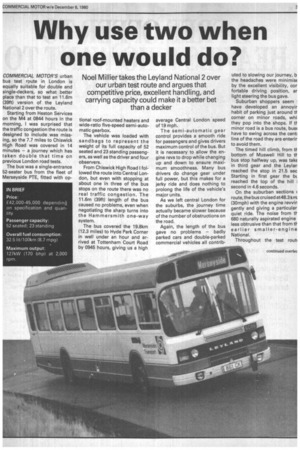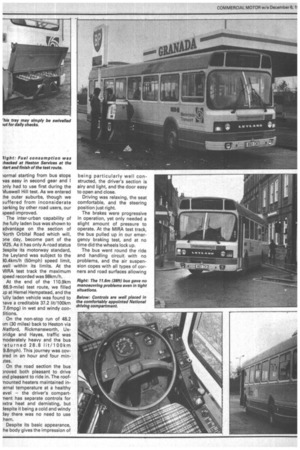Why use two when one would do?
Page 33

Page 34

Page 35

If you've noticed an error in this article please click here to report it so we can fix it.
Noel Millier takes the Leyland National 2 over our urban test route and argues that competitive price, excellent handling, and carrying capacity could make it a better bet than a decker
COMMERCIAL MOTOR'S urban bus test route in London is equally suitable for double and single-deckers, so what better place than that to test an 11.6m (39ft) version of the Leyland National 2 over the route.
Starting from Heston Services on the M4 at 0844 hours in the morning, I was surprised that the traffic congestion the route is designed to include was missing, so the 7.7 miles to Chiswick High Road was covered in 14 minutes — a journey which has taken double that time on previous London road tests.
The bus was a single-entrance 52-seater bus from the fleet of Merseyside PTE, fitted with op tional roof-mounted heaters and wide-ratio five-speed semi-automatic gearbox.
The vehicle was loaded with sandbags to represent the weight of its full capacity of 52 seated and 23 standing passengers, as well as the driver and four observers.
From Chiswick High Road I followed the route into Central London, but even with stopping at about one in three of the bus stops on the route there was no real traffic congestion. The 11.6m (39ft) length of the bus caused no problems, even when negotiating the sharp turns into the Hammersmith one-way System.
The bus covered the 19.8km (12.3 miles) to Hyde Park Corner in well under an hour and arrived at Tottenham Court Road by 0945 hours, giving us a high average Central London speed of 19 mph.
The semi-automatic gear control provides a smooth ride for passengers and gives drivers maximum control of the bus. But it is necessary to allow the engine revs to drop while changing up and down to ensure maximum smoothness. Many bus drivers do change gear under full power, but this makes for a jerky ride and does nothing to prolong the life of the vehicle's major units.
As we left central London for the suburbs, the journey time actually became slower because of the number of obstructions on the road.
Again, the length of the bus gave no problems — badly parked cars and double-parked commercial vehicles all contrib
uted to slowing our journey, b the headaches were minimisE by the excellent visibility, cor fortable driving position, ar light steering the bus gave.
Suburban shoppers seem • have developed an annoyir habit of parking just around ticorner on minor roads, whi they pop into the shops. If minor road is a bus route, bus( have to swing across the centi line of the road they are enterir to avoid them.
The timed hill climb, from tlbottom of Muswell Hill to if bus stop halfway up, was take in third gear and the Leylar reached the stop in 21.5 sec Starting in first gear the bt reached the top of the hill i second in 4.6 seconds.
On the suburban sections route, the bus cruised at 48.3 km, (30mph) with the engine revvin gently and giving a particular quiet ride. The noise from V680 naturally aspirated engine less obtrusive than that from tlearlier smaller-engine National.
Throughout the test rout' iormal starting from bus stops vas easy in second gear and I Pnly had to use first during the Vluswell F(iII test. As we entered :he outer suburbs, though we 3uffered from inconsiderate parking by other road users, our 3peed improved.
The inter-urban capability of :he fully laden bus was shown to advantage on the section of North Orbital Road which will, pne day, become part of the V125. As it has only A-road status Pespite its motorway standard, :he Leyland was subject to the 30.4km/h (50mph) speed limit, Nell within its limits. At the V1IRA test track the maximum 3peed recorded was 98km/h.
At the end of the 110.9km 68.9-mile) test route, we filled ip at Hemel Hempstead, and the 'ully laden vehicle was found to lave a creditable 37.2 lit/100km 7.6mpg) in wet and windy conlitions.
On the non-stop run of 48.2 cm (30 miles) back to Heston via Natford, Rickmansworth, Uxpridge and Hayes, traffic was noderately heavy and the bus • eturned 28,8 lit/1 0 Okm 9.8mph). This journey was coyaxed in an hour and four mines.
On the road section the bus proved both pleasant to drive ind pleasant to ride in. The roof-nounted heaters maintained inernal temperature at a healthy evel — the driver's compart-nent has separate controls for )xtra heat and demisting, but lespite it being a cold and windy Jay there was no need to use hem.
Despite its basic appearance, he body gives the impression of being particularly well constructed, the driver's section is airy and light, and the door easy to open and close.
Driving was relaxing, the seat comfortable, and the steering position just right.
The brakes were progressive in operation, yet only needed a slight amount of pressure to operate. At the MIRA test track, the bus pulled up in our emergency braking test, and at no time did the wheels lock up.
The bus went round the ride and handling circuit with no problems, and the air suspension copes with all types of corners and road surfaces allowing the bus to be driven hard with; out causing too much passenger discomfort.
Controls are all easy to reach and can be operated without the need for the driver to take his eyes off the road — and the single-spoke steering wheel en
sures that none are obscured.
Instrumentation consists of a central speedometer with air gauges at either side, warning lights are grouped at either side of the speedometer and have a test button, and indicators, horn and headlights flash are on a stalk to the right of the steering column.
Switches to the right of the driving position include heater and demister controls, the gearchange control, spring brake lever, windscreen wiper and wash control and finally, at the drivers right hand, switches for exterior and interior lights, a master switch, a stop-start switch and all other controls.
The 52 seats are covered with vinyl coated leathercloth, and a large luggage pen is fitted just behind the entrance door. Moquette seating is available as an option and on our test bus the driver's seat was moquette covered.
The only item needing daily checks from inside the bus was the windscreen washer, which is located behind a panel in the front bulkhead.
I felt that the inside of the bus itself would be easy to clean and maintain; interior cladding is of light-coloured plastic laminate and all stanchions are finished in black.
Interior lights are also easy to clean, with fluorescent tubes mounted above the centre aisle, and many body parts are standard throughout the model range — a factor which makes for convenient repair and long vehicle life.
The Leyland National 2 is of fully integral construction, and unlike the National 1 has a front mounted radiator cooled by ar eight-blade thermostaticall■ controlled hydraulicalh. operated fan.
Access to the engine compart ment is via floor traps and exter nal flaps at the rear, rear near side and offide. Provision fo daily checks is from outside thr vehicle.
Unlike the 1, no flap over thr cooling system cap is fitted as i has proved impracticable.
Injectors did seem difficult bu not impossible to get at withou removing the silencer, but thh operation in itself would not bi too hard.
With its trusted and powerfu naturally aspirated 680 engine the appeal of the Leylanr National has been obviousl, widened by the Mark 2 version.
Despite its offering the sophis tication of low floor air sprum city bus, there is little about thi vehicle that is complicated or Ii kely to be difficult to maintain.
Currently priced at betweei £42,000 and £45,000 thi National 2 is particularly compe titive and with its 75 passenge carrying capacity and long I& potential could well win nev friends and provide value fo money, while still providing es pecially attractive public trans port.
The National production plan has a reputation for prompt de livery and the bus, being a singli complete vehicle, minimise! both time and paperwork befori delivery.
The bus's initial cost and pas senger capacity together with it running costs could make it better proposition in some area than a double-decker.












































































































































